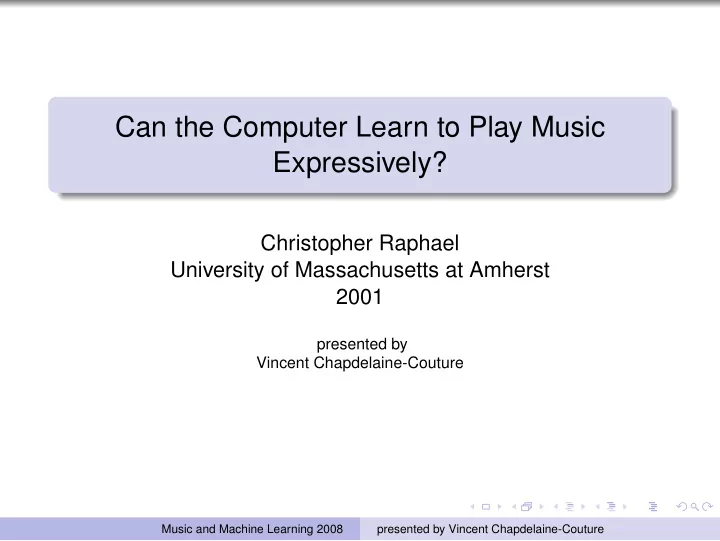

Can the Computer Learn to Play Music Expressively? Christopher Raphael University of Massachusetts at Amherst 2001 presented by Vincent Chapdelaine-Couture Music and Machine Learning 2008 presented by Vincent Chapdelaine-Couture
Introduction Music++ (Music Plus One): REAL-TIME musical accompaniment for a LIVE soloist playing a piece of NON-IMPROVISED music. Required Learning Input: score, previous (repeatable) soloist and accompaniment performances. Thus, it is usually NOT used in the following cases: Music and Machine Learning 2008 presented by Vincent Chapdelaine-Couture
Main components Goal: synchronize accompaniment with soloist based on predictions: learn from past soloist performances in order to make predictions; respond in real-time to the soloist’s tempo changes and expressiveness. Music++ has 2 main components: Listen: estimate note onsets from accoustic signal (soloist or accompaniment). C. Raphael Automatic Segmentation of Acoustic Musical Signals Using Hidden Markov Models IEEE Trans. on PAMI vol. 21, no. 4, 360–370, 1999. Play: Bayesian Belief network that can be used to schedule an optimal accompaniment. C. Raphael Can the Computer Learn to Play Music Expressively? Proc. of Eighth Int. Workshop on Artif. Intel. and Stats., 113–120, Morgan Kauffman, 2001. Music and Machine Learning 2008 presented by Vincent Chapdelaine-Couture
Listen component Listen is trainable for new solo instrument, room acoustics, microphone placement: Divide signal in blocks of, say, 32ms. Assign each block a label from the set { rest , pitch i , artic i } , where 1 < = i < = n , n being the number of notes in the score. Use HMM to produce (real-time but delayed) n note onsets. Robust to inaccuracies and embellishments by soloist? Music and Machine Learning 2008 presented by Vincent Chapdelaine-Couture
Play component Play is a Bayesian Belief Network with: observable variables: note onsets, known note times from score. unobservable variables: local tempo, change in tempo, and rhythmic stress. Offline: training from soloist and accompaniment performances, separately first and then joined. Online: compute in real-time the optimal accompaniment. Music and Machine Learning 2008 presented by Vincent Chapdelaine-Couture
Input I Musical score: gives the pitches, positions and relative durations of the various notes points of synchronization between the soloist and accompaniment Music and Machine Learning 2008 presented by Vincent Chapdelaine-Couture
Input II Previous soloist and accompaniment performances (not playing at the same time). The solo data is used learn how to predict the future evolution of the solo part and to know what can and cannot be predicted reliably. The accompaniment data is used to learn musicality (onset sequence, volumes). Music and Machine Learning 2008 presented by Vincent Chapdelaine-Couture
Input II (cont.) Music and Machine Learning 2008 presented by Vincent Chapdelaine-Couture
Input III Soloist’s live performance: Note onsets; Delayed output to resolve local ambiguities (accompaniment will start late; no visual cues from conductor). Music and Machine Learning 2008 presented by Vincent Chapdelaine-Couture
The solo model where l n is the musical length of the n th note in beats and the ( τ n , σ n ) t and ( t 0 , s 0 ) t are mutually independent Gaussian random vectors. Mean of σ n is: negative: soloist is usually speeding-up; positve: soloist is usually slowing-down. Mean of τ n is: negative: compressions in time (without any change in tempo) positive: stretches in time (without any change in tempo) Changes are nearly deterministic (low variance) or quite variable (high variance). Music and Machine Learning 2008 presented by Vincent Chapdelaine-Couture
The solo model (cont.) is rewritten as: Unknown distributions are x solo and { ξ solo } n 0 Music and Machine Learning 2008 presented by Vincent Chapdelaine-Couture
Training the solo model Noisy observations: quantization, misfires from Listen process. Imprecisions from soloist,.... B is (1,0). The { ξ obs } have 0-means and fixed variances. n Use EM to learn a posteriori distribution of the unobserved { x solo } . n Music and Machine Learning 2008 presented by Vincent Chapdelaine-Couture
Training the solo model (cont.) We now have estimates of the black and white nodes below... Use EM to learn a posteriori distribution of the unobserved { ξ solo } vectors. n Music and Machine Learning 2008 presented by Vincent Chapdelaine-Couture
Adding the accompaniment MIDI variables for the accompaniment: Damping times is deterministic (legato, staccato). Velocities (volumes) are learned accompaniment performance (eg./ volume w.r.t score position, phrase), and applied in deterministic manner. Note onsets determines synchronisation: this is the more important and difficult part! Note: no dependency between velocities and onset times. Music and Machine Learning 2008 presented by Vincent Chapdelaine-Couture
The accompaniment model The accompaniment is first trained as with the soloist to get Gaussian distributions for each note. The Tricky Part: accompaniment must follow the soloist! Solution: the conditional distribution of the accompaniment part GIVEN the solo part. Music and Machine Learning 2008 presented by Vincent Chapdelaine-Couture
Combining the solo and accompaniment models Consider a section of the accompaniment part "sandwiched" between two solo notes: Music and Machine Learning 2008 presented by Vincent Chapdelaine-Couture
The big picture... Music and Machine Learning 2008 presented by Vincent Chapdelaine-Couture
Predicting the future Predictive model: scheduling the pending accompaniment note every time new information becomes available (see red lines). Note: onsets are detected with a small amount of latency (see green lines). Music and Machine Learning 2008 presented by Vincent Chapdelaine-Couture
Discussion What if: a wrong note is played thrills are added, or other embellishment a measure is repeated Mozart Rondeau example:: Noise (eg./ croud), huge tempo changes. Music and Machine Learning 2008 presented by Vincent Chapdelaine-Couture
Questions? Questions? Music and Machine Learning 2008 presented by Vincent Chapdelaine-Couture
Recommend
More recommend